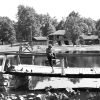calsfoundation@cals.org
Harold Raymond (Hal) Smith (1931–2014)
Harold Raymond (Hal) Smith of Barling (Sebastian County) became the starting catcher for the St. Louis Cardinals in his rookie season, 1956, and held that position until a heart valve condition caused his retirement as a player in 1961. Playing in 570 games, Smith had a major league batting average of .258 and hit twenty-three home runs. Known for his rifle-shot throwing arm, Smith listed superstars Willie Mays, Hank Aaron, and Roberto Clemente—Baseball Hall of Fame members and the best base runners of the era—among his “thrown out trying to steal second” victims.
Hal Smith was born on June 1, 1931, to Katherine and Ronald Smith, who operated a grocery and gas station along Highway 22; he had three sisters and two brothers. Smith played baseball for the Randall Victors, the Fort Smith American Legion team. In the 1948 state tournament at Travelers’ Field in Little Rock (Pulaski County), Smith batted .422 and played so well behind the plate that Arkansas Democrat sportswriter Charles Allbright dubbed him the most valuable player, even though the Victors lost to the Little Rock Doughboys by a score of 3–1. Soon afterward, Smith signed a contract with the Cardinals and was sent to Albany, Georgia, for the 1949 minor league season.
In March 1950, just before the next season, he married Carolyn Treece of Fort Smith (Sebastian County). They honeymooned at Niagara Falls en route to reporting to his new ballclub in Hamilton, Ontario; the couple eventually had two daughters and a son. Smith served in the U.S. Army during the Korean War.
After seven years in the minors and a winter season in Mexico being tutored by such legendary coaches as Vedie Himsl, Harry Walker, Dixie Walker, and George Kissell, Smith reached the majors with the Cardinals in 1956, joining a team with Stan Musial, Red Schoendienst, Ken Boyer, Jackie Brandt, and Wilmer “Vinegar Bend” Mizell. A month into his rookie season, Smith because the starting catcher for the Cardinals.
After the 1956 major league season, Smith opted to play winter baseball in Cuba. He, along with his wife and two daughters, settled into a cottage in Havana, where he played four months with the Marianao Tigres. The Tigres club had signed Smith, pitcher Jim Bunning, and outfielders Minnie Minoso and Solly Drake of Little Rock (Pulaski County). With high-producing American players in key positions, Marianao won the Cuban League and went on to win the Caribbean World Series.
In 1957, Smith’s sophomore season, St. Louis made a strong run for the pennant, finishing second to the Milwaukee Braves. Smith batted .279 and was voted by players and managers as a National League All Star. In November 1958, the Cardinals went on a playing tour of Asia, where they took on the best of the Japanese teams.
On July 30, 1959, Smith caught Bob Gibson’s first major league win, a 1–0, nine-inning complete game shut out of the Cincinnati Reds. In September 1959, a Cardinal victory temporarily derailed the Dodgers’ quest for the pennant. Behind by three runs, the Cardinals loaded the bases with two outs against the great Dodger lefthander, Sandy Koufax. Smith came to the plate and, on a count of one ball and two strikes, smashed a Koufax delivery out of the park. Over the radio, the Cardinal announcer, Harry Caray, exclaimed, “They’re dancing in the streets of Barling, Arkansas!” Thus did Smith earn his nickname, the “Barling Darling.”
That was Smith’s thirteenth home run in a season, and he was again voted onto the National League All Star teams (there were two games that years). He also caught for Cardinal pitchers Ray Sadecki, Von McDaniel, Bob Blaylock, Bob Miller, and Ernie Broglio in their first major league starts.
In June 1961, Smith had persistent chest paints and was diagnosed with a heart valve condition. Doctors recommended that he stop playing. Smith therefore accepted an offer to become an instructor for the club and, in 1962, rejoined the Cardinals as an on-field coach. He later coached with the Cincinnati Reds, Pittsburgh Pirates (who put him behind the plate for four games in 1965), and the Milwaukee Brewers. Smith finished his career as a scout for the Cardinal organizations. He retired in 1997 and moved to Fort Smith.
In 2001, Smith was inducted into the Hall of Fame of the Fort Smith Boys & Girls Club. His career in baseball had begun in Fort Smith when he was an American Legion player in 1948. He was elected to the Arkansas Sports Hall of Fame in 2005.
Smith died on April 12, 2014, in Fort Smith.
For additional information:
The Baseball Encyclopedia: The Complete and Definitive Record of Major League Baseball. 9th ed. New York: Macmillan, 1993.
Harris, Bruce. “Hal R. Smith: ‘The Finest Arm of Any Catcher in the League.” Journal of the Fort Smith Historical Society 45 (September 2021): 47–52.
Higgins, Billy D. The Barling Darling: Hal Smith in American Baseball. Little Rock: Butler Center Books, 2009.
Korr, Charles A. End of the Game As We Know It: Marvin Miller and the Coming of the Baseball Players Union. Urbana: University of Illinois Press, 1998.
Billy D. Higgins
University of Arkansas at Fort Smith






Comments
No comments on this entry yet.